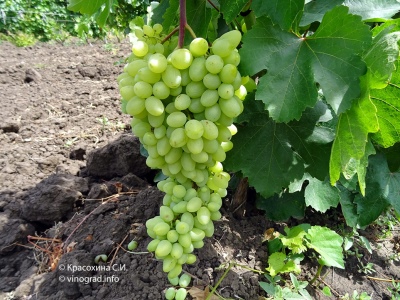
- Authors: V.V. Zagorulko, Ukraine
- Appointment: universal
- Berry color: white-yellow
- Taste: nutmeg
- With bones: No
- Ripening period: very early
- Ripening period, days: 95-100
- Frost resistance, ° C: -21
- Bunch weight, g: 800-3000
- Flower type: bisexual
The Heliodor grape is a decent versatile variety. Its high yield fully justifies growing. This plant also belongs to the seedless group, which increases its consumer qualities.
Breeding history
The main varietal development was carried out in Ukraine. V.V. Zagorulko made a significant contribution to breeding work. The plant was created by crossing previously known types. The initial species had early and very early ripeness, which eloquently indicates the main task. However, it did not work out to achieve outstanding qualities - it turned out just solid grapes.
Description
Ripening period
The berries are ready for picking 95-100 days after planting. This allows us to confidently attribute Heliodor to especially early varieties. The harvest can survive on the branches until the last summer days.
Bunches
The brushes of this variety are highly branched. They are characterized by elongation. The mass of one cluster of fruits varies from 800 g to 3 kg.
Berries
The surface is painted white and yellow. An attractive feature is the lack of pits on the inside. Geometrically, the fruit looks like an oblong oval. The rind is moderately thick and relatively firm, but does not excel in these areas. The flesh of Heliodor is very dense; a berry can weigh from 6 to 7 g.
Taste
Tasters note the characteristic nutmeg notes. There is no taste from the peel. The pulp is quite elastic. Good taste persists for a very long time, at least until the end of summer. And also the juiciness of the fruit attracts attention.
Yield
Normal fertility of one vine is no more than 3 kg. Otherwise, the plant will be overwhelmed. Heliodor bears fruits of the 3rd class, rudiments are quite common. In the first season, the collection from 0.8 to 1.5 kg is quite decent. Then the bar can be raised.


Growing features
Landing
Due to the very early ripening, planting can be postponed until a favorable moment. But not too long. It is advisable only to wait for the sure end of the cold weather. Autumn planting is also possible. For Heliodor, illumination is critically important, that is, it cannot be planted on shady areas; Annual seedlings have long been recognized as the best material.

Pollination
The flowers of this variety are bisexual. Additional plantings for pollination activity are usually not required. Bees are lured into the vineyard in the same way as usual.
Pruning
In one area of the vine, you can leave both 2-3 and 4-6 eyes. This leaves winegrowers a fair amount of room to maneuver.Normalizing pruning is a must. No more than 12 shoots are allowed per 1 m of the bush. Any weak growth should be destroyed without hesitation.



Top dressing
This procedure is carried out as needed. It is not worth striving to "feed" the plant. The optimal solution is to add sulfates without exceeding the dosage. Between planting and the beginning of the formation of berries, Heliodor does not need fertilizing. More precisely, it can be said only for each specific situation.
Frost resistance and the need for shelter
The developers of the variety insist that its frost resistance reaches –21 degrees. Nevertheless, you still have to cover the vineyard. The more humid the area, the more relevant this measure is. There are no more detailed instructions regarding the shelter in the available sources.

Diseases and pests
Fungal resistance is classified as 3 points. Of the diseases, the danger is oidium. The fight against it is carried out mainly with the help of the drug "Topaz". And also carries a threat and mildew; for its prevention, the plants are fed carefully, and if the ailment nevertheless occurs, fungicides are used according to the instructions. There is no information on pests of this particular variety; the facts of mite infestation were noted.

If a grape is exposed to any disease or insect, this always affects its appearance.
Storage
For storage of crops, clean and dry containers are recommended. It is advisable to place them in cool places. Small berries are predominantly classified as raisins and should be stored accordingly. If possible, keep the fruit in refrigerators for more than 24 hours.











































































